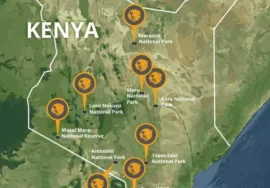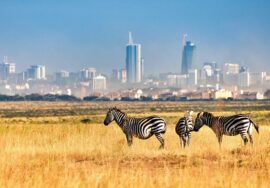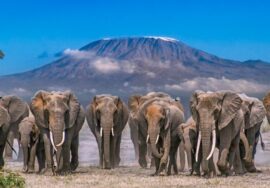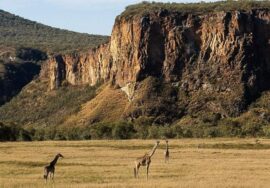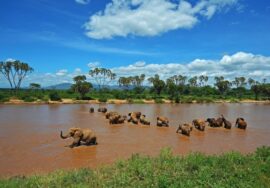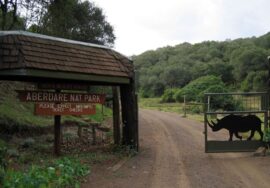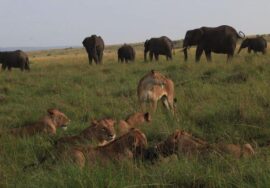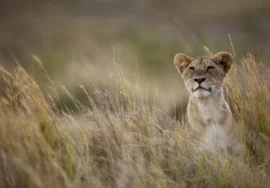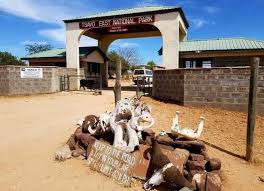
TSAVO EAST NATIONAL PARK
There are many drinking holes in Tsavo that are used by lions, leopards, buffalo, elephants, and many smaller animals like gerenuk, impala, and Masai giraffe to stay hydrated. You’ll also find the Galana River, which runs through the park and has lush vegetation along its banks.
What are the red elephants of Tsavo East?
Herds of elephants quench their thirst along the rivers and at different waterholes. This is probably the park’s best feature. As was already said, they like to roll around on the ground and take baths in the deep red dirt. Because they look so red afterward, people often call them “red elephants.” If you’re lucky, you might also see a water show as the big pachyderms spray each other as part of their grooming routine.
The Tsavo East National Park is home to lions and other animals.
There are hundreds of lions in the park, but Tsavo Lions are always different. The adult males don’t have the lion’s hair, which gives them a unique look.
You can go on a safari through acacia bush and see Cape buffalo, leopard, giraffe herds, and hippo, crocodile, and waterbuck along the rivers.
Seeing birds in Tsavo East National Park
But the plains and oases of Tsavo also have a huge variety of birds—it is possible to see over 500 kinds. People say that October through January is the best time to watch birds because that’s when migrating birds like skimmers, goshawks, and vultures are most likely to be seen.
There are also buzzards, ostriches, starlings, kingfishers, hornbills, herons, and some very special birds, like the lovebird, the holy ibis, and the crowned crane.
The things you can see in Tsavo East National Park
This natural rock structure, Lugard’s Falls, is on the Galana River. It takes in water from the river in a narrow groove and then spits out a stream that flows into rapids and pools below.
Aruba Dam is a beautiful man-made structure that spans the Voi River. The water in the river attracts a lot of wildlife, including groups of lions.
Rock of Mudanda – In the shape of a whale, this 1.6 km (.99 mi) long rock creation collects water for the natural dam below. Hundreds of elephants in the park are drawn to the water, which makes it a great place to watch them.
The longest lava flow in the world’s history can be seen on the Yatta Plateau. It’s more than 300 km long and goes along the western edge of the park, above the Athi River.
Facts About Tsavo East National Park
Tsavo is Kenya’s biggest park, with an area of 11,747 square kilometers (4535 square miles). It is also one of the oldest parks, having been built in 1948.
The park is between Nairobi, which is the capital, and Mombasa, which is on the coast. It’s easy to go on safari from either place because it’s close to the coast of Kenya.
The weather here is hot and dry; during the day it will be 31°C/88°F and at night it will be 20°C/68°F. April and November are the rainy months.
The park is open all year, but the best times to see animals are in the dry months, from June to October, and in January and February, when they gather at the rivers and other drinking holes.
The business is open from 6 am to 6 pm. You can only hike with a Kenya Wildlife Service guide with you.
How to get there: Safari Trips to Kenya can help you book a tour. It will be a style trip because the 4×4 safari Jeep is specially equipped for it.
By air: There are several airstrips close to the park.
By train: Get on the Madaraka Express, which is Kenya’s newest high-class train. We can take care of everything.

